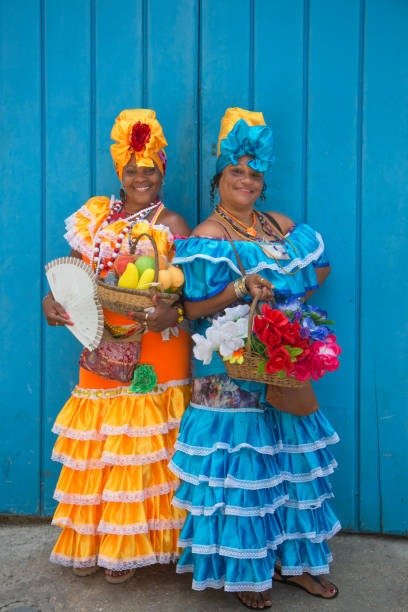
Traditional Cuban Clothing: Preserving Heritage Through Fashion:
Introduction
Traditional Cuban Clothing: Preserving Heritage Through Fashion: Traditional Cuban clothing is more than just fabric and stitches; it’s a living testament to the island’s past and present. From the colorful guayaberas to the elegant bata cubana, each garment carries a piece of Cuba’s story. In this article, we will explore the different elements of Cuban clothing, their historical roots, and how they continue to influence fashion today.
Historical Background
The Colonial Era
Cuban clothing has evolved significantly over the centuries. During the colonial period, Spanish settlers introduced European styles, which mingled with local traditions. The result was a unique fusion that laid the foundation for modern Cuban fashion.
The Afro-Cuban Influence
The arrival of African slaves in the 16th century added another layer to Cuban fashion. African influences are evident in the use of vibrant colors, patterns, and fabrics, as well as in traditional garments like the bata cubana. This blend of African and Spanish elements created a distinctive Cuban style that persists today.
The Revolution and Beyond
The Cuban Revolution of 1959 brought significant changes to Cuban society, including its fashion landscape. While the revolution promoted a sense of unity and equality, traditional clothing remained an essential part of Cuban identity. In the years that followed, Cuban fashion continued to evolve, incorporating both revolutionary ideals and historical influences.
Key Elements of Traditional Cuban Clothing
The Guayabera
Traditional Cuban Clothing: Preserving Heritage Through Fashion: The guayabera, often referred to as the “Cuban shirt,” is one of the most iconic pieces of Cuban clothing. Originally designed for comfort in the hot Cuban climate, this shirt is characterized by its lightweight fabric, four front pockets, and intricate embroidery. The guayabera has become a symbol of Cuban culture, worn by both men and women for formal and casual occasions.
Origins and Evolution
The guayabera’s origins are somewhat debated, but it is widely believed to have been introduced in Cuba during the 19th century. The shirt’s name is derived from the Spanish word for “guava,” as it was initially worn by men who worked in guava orchards. Over time, the guayabera gained popularity among Cuban elites and became a staple in Cuban fashion.
Modern Adaptations
Today, the guayabera is celebrated for its versatility and style. It is often worn at weddings, social gatherings, and even in professional settings. Modern variations of the guayabera feature different fabrics, colors, and designs, reflecting both traditional and contemporary tastes.
The Bata Cubana
The bata cubana is another traditional garment with deep cultural roots. This elegant, flowing dress is often adorned with intricate embroidery and is worn for formal events and religious ceremonies.
Cultural Significance
The bata cubana holds significant cultural and spiritual importance in Cuban society. It is often worn during Santería rituals, a religion that blends African and Catholic elements. The dress is symbolic of the wearer’s connection to their cultural heritage and spiritual beliefs.
Variations and Styles
While the bata cubana traditionally features a long, flowing silhouette, contemporary versions may incorporate modern design elements. Variations in color, fabric, and embellishment reflect the wearer’s personal style and the occasion.
The Mambo Skirt
The mambo skirt is a vibrant, flouncy skirt often worn by women during festive occasions. Named after the energetic mambo dance, this skirt reflects the lively spirit of Cuban culture.
Design and Function
Characterized by its bright colors and ruffled layers, the mambo skirt is designed to move with the wearer, enhancing the dance experience. It is typically paired with a fitted blouse or top, creating a dynamic and eye-catching ensemble.
Popularity and Cultural Impact
The mambo skirt has become a symbol of Cuban dance and music. It is often worn during festivals, parades, and performances, showcasing the island’s rich musical heritage and celebratory spirit.
Traditional Fabrics and Materials
Linen
Traditional Cuban Clothing: Preserving Heritage Through Fashion: Linen is the fabric of choice for many traditional Cuban garments, including the guayabera. Its breathability and lightweight nature make it ideal for Cuba’s tropical climate.
Cotton
Cotton is another popular fabric in Cuban clothing. Its versatility and comfort make it suitable for everyday wear. Many traditional garments, including the mambo skirt, are made from cotton.
Silk
Silk is often used for more formal and elegant garments, such as the bata cubana. Its smooth texture and luxurious appearance add a touch of sophistication to traditional Cuban attire.
Contemporary Cuban Fashion
Fusion of Old and New
Modern Cuban fashion continues to draw inspiration from traditional clothing while incorporating contemporary trends. Designers often blend traditional fabrics and techniques with modern cuts and styles, creating a unique fusion that honors the past while embracing the future.
Global Influence
Cuban fashion has also made its mark on the global stage. Cuban designers are gaining recognition for their innovative approaches, and traditional garments like the guayabera are celebrated worldwide. This global influence reflects Cuba’s rich cultural heritage and its impact on international fashion.
Fashion in the Diaspora
The Cuban diaspora has also played a significant role in preserving and promoting traditional Cuban clothing. Cuban communities abroad continue to celebrate their heritage through fashion, ensuring that traditional garments remain an important part of their cultural identity.
Preserving Cultural Heritage Through Fashion
The Role of Fashion Institutions
Traditional Cuban Clothing: Preserving Heritage Through Fashion: Fashion institutions in Cuba play a crucial role in preserving traditional clothing and promoting its significance. Museums, cultural centers, and fashion schools are dedicated to studying and showcasing Cuban fashion history, ensuring that traditional garments are celebrated and preserved for future generations.
Community Efforts
Local communities and cultural organizations also contribute to preserving Cuban fashion heritage. Through festivals, exhibitions, and educational programs, these groups help keep traditional clothing alive and relevant in today’s world.
The Future of Cuban Fashion
The future of Cuban fashion lies in balancing tradition with innovation. As Cuban designers continue to explore new creative avenues, traditional garments will likely continue to evolve while maintaining their cultural significance. The fusion of old and new will ensure that Cuban fashion remains dynamic and reflective of the island’s rich heritage.
Conclusion
Traditional Cuban Clothing: Preserving Heritage Through Fashion: Traditional Cuban clothing is a vibrant expression of the island’s rich cultural history. From the iconic guayabera to the elegant bata cubana, each garment tells a story of Cuba’s past and present. As Cuban fashion continues to evolve, preserving these traditions remains crucial in celebrating and honoring the island’s unique heritage. By embracing both tradition and innovation, Cuban clothing will continue to be a living testament to the island’s rich cultural tapestry.
Frequently Asked Questions
Q:1 What is a guayabera?
A:1 A guayabera is a traditional Cuban shirt characterized by its lightweight fabric, four front pockets, and intricate embroidery. It is a versatile garment worn for both formal and casual occasions.
Q:2 What is a bata cubana?
A:2 A bata cubana is an elegant, flowing dress often adorned with intricate embroidery. It is worn for formal events and religious ceremonies, reflecting the wearer’s cultural and spiritual heritage.
Q:3 What is the significance of the mambo skirt in Cuban culture?
A:3 The mambo skirt is a vibrant, flouncy skirt worn during festive occasions. It reflects the lively spirit of Cuban culture and is often associated with dance and music.
Q:4 What fabrics are commonly used in traditional Cuban clothing?
A:4 Traditional Cuban clothing often uses fabrics such as linen, cotton, and silk. Linen and cotton are popular for their breathability and comfort, while silk is used for more formal garments.
Q:5 How has Cuban fashion evolved in recent years?
A:5 Cuban fashion has evolved by blending traditional elements with contemporary trends. Modern Cuban designers incorporate traditional fabrics and techniques into new styles, creating a unique fusion that honors both the past and the present.
See More










